… continuation …
Igor Grishin: 10 rules of playing Go (or Weiqi) on the board
1. In the beginning the board is clear.
2. First move is by black, then in turn.
3. A stone is put on a vacant crossing and doesn’t move
4. Players need to divide the board between each other enclosing parts of the board with their stones. Compete in who can enclose more.
5. If one stone or group of stones is surrounded with opponent’s stones and has no connection with vacant crossings, it needs to be taken off the board. Captured stones are kept till the end of the game.
6. There are some forbidden places where one can’t put his or her stone. These are the places where there are no vacant crossings or allied stones nearby but only your opponent’s stones. Self-capturing moves are also prohibited.
7. You can put your stone in “prohibited” place if you capture one or more opponent’s stones with this move. Then the opponent’s stones are taken off the board.
8. You can’t capture a single stone right after it had been used to capture your own single stone. You have to make at least one move somewhere else before such “re-capturing”.
9. The game is over when there are no more segments to be enclosed to make them yours.
10. The winner is the person who has the largest sum of enclosed territory and prisoners.
Timur! I’ve got ten rules.
But some of the rules are not clear enough, do you think? In reality playing is much easier. It is a lot harder to word it. Let the reader try himself, may he can explain the rules easier.
By the way, I have a lot simpler formula that our kids use when instructing beginners.
It sounds like this:
“Go – is a very interesting game,
we begin on a clear board,
first move black, then in turn,
a stone is put on a crossing and can no longer move,
the aim is to divide the board, enclosing it,
stones can be captured,
the captured stones are those that have no more “branches”,
the one who has more territory and captured stones wins.
There is only one rule, that we haven’t mentioned, but we can play without it for now.
Let’s play!”
In my perspective, it is a lot better not only to play Go, but to learn Go. However you call the thing you do so it will be for you. At that occasionally happens so.
That’s why I decide to work out my …
10 rules of how to play Go in life
1. First you have no ideas as well as stones.
2. Life moves first.
3. A stone is a deed and it almost can’t be changed.
4. Playing with life, you should build a territory, where your control is as real as life itself.
5. Your stones-deeds can get surrounded and taken off the board, especially, if they are most precious for you. Life never surrounds useless stones.
6. There are times when deeds are not possible. You will be able to understand it yourself.
7. The moves of reality may become surrounded. If this happens, it’s your serious achievement. But you should be able to determine: was it a sacrifice or you’ve taken stones that were of big value.
8. A ko-fight with reality is as real as everything else.
9. It’s easy to realize when the game is over. If you are still alive – the game goes on.
10. Life usually wins, but according to the theory there should be exceptions.
Timur Saitov: Igor! I’ve never met those rules in any of the books. I only saw the ten commandments of Go. I think I’ll take the risk of giving them here.
The ten commandments of Go
The one who is craving for victory will fail.
If you invaded in the opponent’s sphere of influence, be tolerant.
Look behind before you attack.
If you give up a stone, continue fighting.
Give the lesser things, take the greater things.
If your stones are in danger, give them up without hesitating.
Refrain from scattering.
Whenever your opponent attacks you, fight back immediately.
If your opponent strengthens himself, do the same thing.
If you are isolated with no hope to escape, choose a peaceful path.
I took those from the book of the famous Japanese Master, Otake Hideo.
Now I would like to pass over to the topic of breathing, capturing, and connecting.
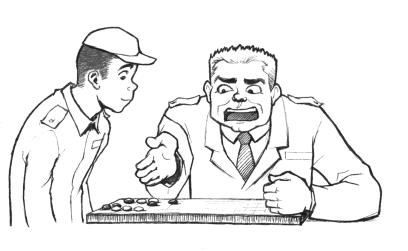
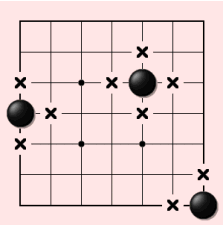
Diagram 5
Usually a stone has four breathing spaces. They are marked with crosses in the diagram. If a stone is on the side, it has only three breathing spaces. And if a stone is in the corner it has only two of them.
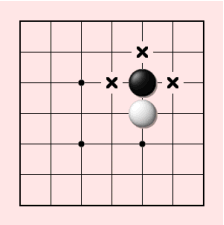
Diagram 6
White puts a stone by the black one. Now the black stone has three breathing spaces.

Diagram 7
Now the black stone has only one breathing space left. And if white puts another stone…
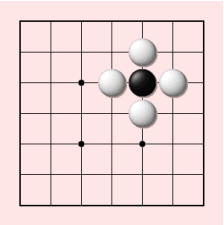
Diagram 8
… the black stone will lose it’s last breathing space and, according to the rules of Go, it should be taken off the board. The stone is taken off by the player who has covered the last breathing space. Without taking the stone off the move isn’t finished.
Igor Grishin: So then stones in Go die of suffocation?
Timur Saitov: Right you are! It happens just this way.
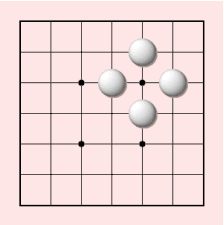
Diagram 9
Surrounded or “suffocated” stone is taken off the board. For each stone that is taken off you get a point at the end of the game. Situation when the stone had only one breathing space left is called atari in Japanese. This means that a stone or a group of stones may be captured with the next move. To capture any group of your opponent’s stones, you should “cover” all the group’s breathing spaces.
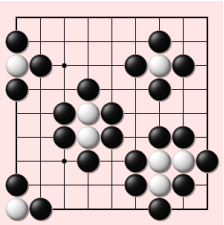
Diagram 10
In this picture black stones surrounded a white stone. This means that white stone should be taken off the board.
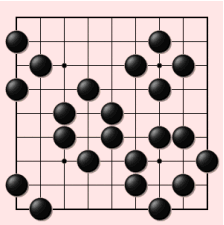
Diagram 11
As you can see in Diagram 10 and 11, the easiest is to capture a stone in the corner. To do this you need only two moves as it has only two breathing spaces. A stone placed in the center of the board is the hardest to be captured, as it has four breathing spaces.
If you don’t want a stone to be captured, like in Diagram 9, you should increase the number of breathing spaces, for example, by putting a stone by the first one.
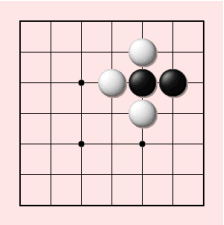
Diagram 12
Two stones have six breathing spaces (can you count them?) and it is harder to capture them.
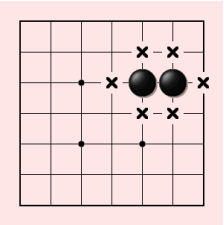
Diagram13
Such adding of a new stone to a stone on the board is called connection of the stones. Two connected stones are considered a group.
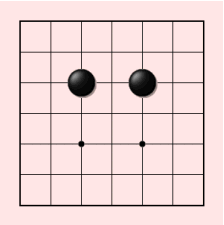
Diagram 14
In the diagram there are two stones. They can be captured separately.
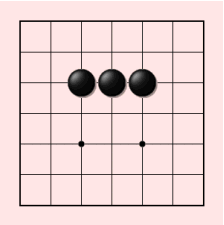
Diagram 15
But being connected those stones are very difficult to capture.
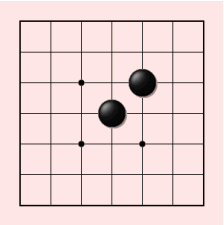
Diagram 16
Beginners may think that the two stones are connected, …
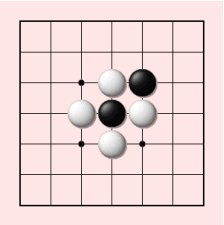
Diagram 17
…but in reality they are not connected as they can be captured separately.
… to be continued …

